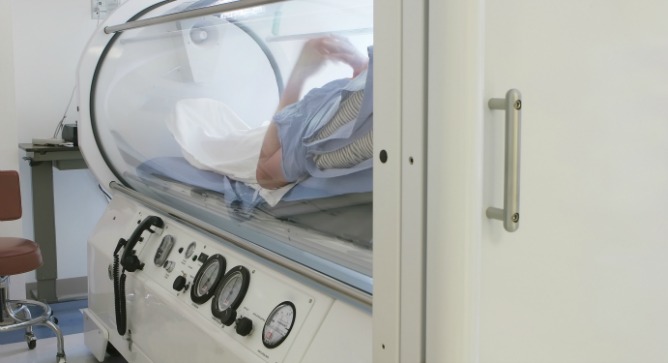Abstract: A decrease in blood glucose levels (BGL) during hyperbaric oxygen treatment (HBOT) is a well-recognised phenomenon, but studies of this are limited and inconclusive. This study evaluated the effect of HBOT on BGL in patients with diabetes mellitus (DM),...
Elevated serum ubiquitin C-terminal hydrolase-L1 levels in patients with carbon monoxide poisoning.
Abstract: Ubiquitin C-terminal hydrolase-L1 (UCH-L1) has been established as a reliable and potential biomarker of neuronal damage after acute neurologic insults, such as ischemic stroke, subarachnoid hemorrhage, and traumatic brain injury. However, the effect of...
A prospective trial of hyperbaric oxygen for chronic sequelae after brain injury (HYBOBI).
Abstract: Some practitioners advocate hyperbaric oxygen (HBO2) for sequelae following brain injury. This study assessed recruitment, tolerance and safety in preparation for a randomized clinical trial. Prospective, open-label feasibility study. Hyperbaric medicine...
[Hyperbaric oxygen therapy and inert gases in cerebral ischemia and traumatic brain injury].
Abstract: Cerebral ischemia is a common thread of acute cerebral lesions, whether vascular or traumatic origin. Hyperbaric oxygen (HBO) improves tissue oxygenation and may prevent impairment of reversible lesions. In experimental models of cerebral ischemia or...
A prospective, randomized Phase II clinical trial to evaluate the effect of combined hyperbaric and normobaric hyperoxia on cerebral metabolism, intracranial pressure, oxygen toxicity, and clinical outcome in severe traumatic brain injury.
Abstract: Preclinical and clinical investigations indicate that the positive effect of hyperbaric oxygen (HBO2) for severe traumatic brain injury (TBI) occurs after rather than during treatment. The brain appears better able to use baseline O2 levels following HBO2...
Neurobiological insight into hyperbaric hyperoxia.
Abstract: Hyperbaric hyperoxia (HBO) is known to modulate aerobic metabolism, vasoreactivity and blood flow in the brain. Nevertheless, mechanisms underlying its therapeutic effects, especially in traumatic brain injury (TBI) and stroke patients, are debated. The...
Microglial activation induced by traumatic brain injury is suppressed by postinjury treatment with hyperbaric oxygen therapy.
The mechanisms underlying the protective effects of hyperbaric oxygen (HBO) therapy on traumatic brain injury (TBI) are unclear. TBI initiates a neuroinflammatory cascade characterized by activation of microglia and increased production of proinflammatory cytokines. In this study, we attempted to ascertain whether the occurrence of neuroinflammation exhibited during TBI can be reduced by HBO. TBI was produced by the fluid percussion technique in rats. HBO (100% O2 at 2.0 absolute atmospheres) was then used at 1 h (HBO I) or 8 h (HBO II) after TBI. Neurobehavior was evaluated by the inclined plane test on the 72 h after TBI and then the rats were killed. The infarction area was evaluated by Triphenyltetrazolium chloride. Immunofluorescence staining was used to evaluate neuronal apoptosis (TUNEL + NeuN), microglial cell aggregation count (OX42 + DAPI), and tumor necrosis factor-alpha (TNF-α) expression in microglia cell (OX42 + TNF-α). The maximum grasp angle in the inclined plane test and cerebral infarction of the rats after TBI were significantly attenuated by HBO therapy regardless of whether the rats were treated with HBO 1 or 8 h after TBI compared with the controls. TBI-induced microglial activation, TNF-α expression, and neuronal apoptosis were also significantly reduced by HBO therapy. Our results demonstrate that treatment of TBI during the acute phase of injury can attenuate microgliosis and proinflammatory cytokine TNF-α expression resulting in a neuroprotective effect. Even treating TBI with HBO after 8 h had a therapeutic effect.
Quantitative evaluation of hyperbaric oxygen efficacy in experimental traumatic brain injury: an MRI study.
Abstract: To use DCE-magnetic resonance imaging (MRI) and diffusion-weighted imaging to evaluate the hyperbaric oxygen efficacy (HBO) in experimental traumatic brain injury (TBI). Forty-two rabbits were randomly divided into four groups: TBI, TBI + HBO, sham group,...
Oxygen Chamber can Boost Brain Repair
We always think of brain damage as irreversible, whether it’s a result of a stroke, traumatic injury or metabolic disorder. But three Israeli researchers recently reported that treatment with high levels of oxygen can reinvigorate dormant neurons and improve patients’...
Hyperbaric side effects in a traumatic brain injury randomized clinical trial.
Abstract: To catalog the side effects of 2.4 atmospheres absolute (atm abs) hyperbaric oxygen (HBO2) vs. sham on post-concussion symptoms in military service members with combat-related, mild traumatic brain injury (TBI). Fifty subjects diagnosed with TBI were...

